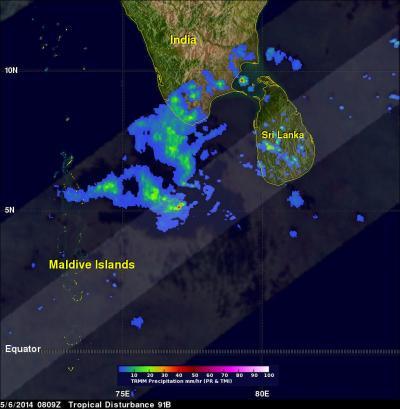A tropical low was affecting southern India and Sri Lanka on May 6 at 0809 UTC when the Tropical Rainfall Measuring Mission satellite called TRMM flew above it. By May 7, System 91B moved over southwestern India and became less organized.
TRMM's Precipitation Radar revealed that rain was falling at a rate of 66 mm (2.6 inches) per hour in the stormy area south of India (5.2 north latitude and 77.1 east longitude). TRMM PR saw the tallest thunderstorm towers over Sri Lanka where heights were pushing to altitudes above 13 km (8 miles).
On May 7 at 12:30 UTC/8:30 a.m. EDT, System 91B was located near 10.0 north latitude and 76.9 east longitude, approximately 35 nautical miles (40 miles/64.8 km) east of Cochin, India.

On May 6, the TRMM satellite saw that some rain in System 91B was falling at a rate of 66 mm (2.6 inches) per hour in the stormy area southwest of India The tallest thunderstorm towers over Sri Lanka were above 13 km (about 8 miles).
(Photo Credit: Image : SSAI/NASA, Hal Pierce)
According to the Joint Typhoon Warning Center, today's animated infrared satellite imagery shows the system has moved inland over the southwestern interior of India. As a result, the large low-level center of circulation is now ill-defined and the remnant thunderstorms are over the western quadrant of the storm.
Maximum sustained surface winds are estimated at 10 to 15 knots (11.5 to 17.2 mph/18.5 to 27.7 kph) and minimum sea level pressure is estimated to be near 1006 millibars. As a result of the low moving over land, the chances for it to organize into a tropical depression over the next 24 hours have dropped from medium to low.
The TRMM satellite was launched by NASA and JAXA in 1997 with the first earth orbiting active/passive instrument package to study the intensity and structure of tropical rainfall. The Global Precipitation Mission satellite that was launched on February 27, 2014 will continue TRMM's highly successful mission of monitoring precipitation from space.
Source: NASA/Goddard Space Flight Center